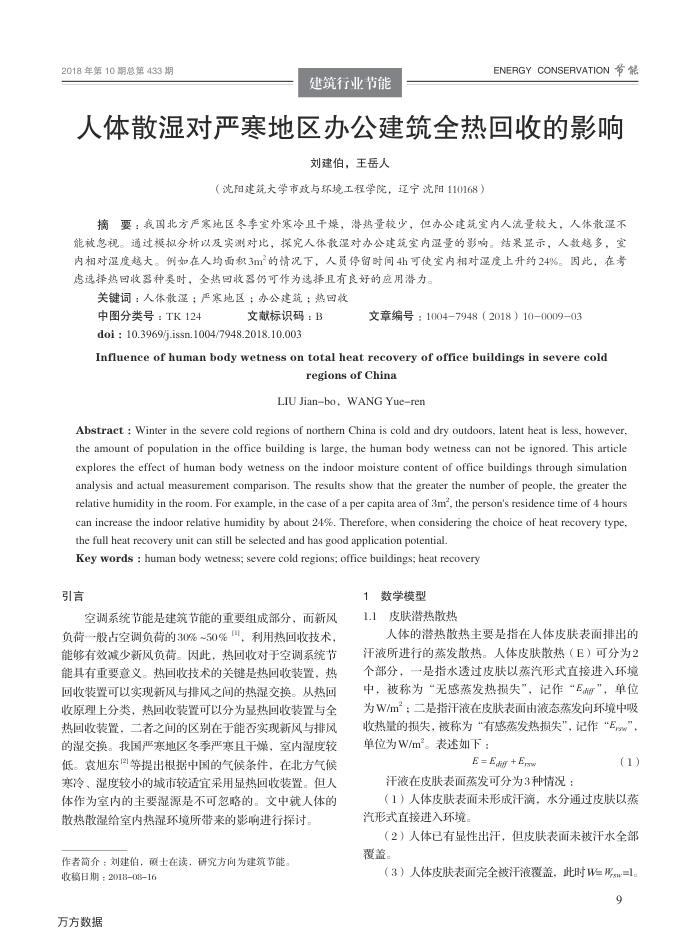您当前的位置:首页>论文资料>人体散湿对严寒地区办公建筑全热回收的影响
内容简介
 2018年第10期总第433期
2018年第10期总第433期建筑行业节能
ENERGYCONSERVATION节能
人体散湿对严寒地区办公建筑全热回收的影响
刘建伯,王岳人
(沈阳建筑大学市政与环境工程学院,辽宁沈阳110168)
摘要:我国北方严寒地区冬季宝外寒冷且千燥,潜热量较少,但办公建筑室内人流量较大,人体散湿不能被急视。通过模拟分析以及实测对比,探究人体散湿对办公建筑室内湿量的影响。结果显示,人数越多,室内相对湿度越大。例如在人均面积3m的情况下,人员停留时间4h可使室内相对湿度上升的24%。固此,在号虑选择热回收器种类时,全热回收器仍可作为选择且有良好的应用潜力。
关键词:人体散湿;严寒地区:办公建筑:热回收
中图分类号:TK124
文献标识码:B
doi : 10.3969/j.issn.1004/7948.2018.10.003
文章编号:1004-7948(2018)10000903
Influence of human body wetness on total heat recovery of office buildings in severe cold
regions of China
LIU Jianbo,WANGYueren
Abstraet : Winter in the severe cold regions of northern China is cold and dry outdoors, latent heat is less, however, the amount of population in the office building is large, the human body wetness can not be ignored. This article explores the effect of human body wetness on the indoor moisture content of office buildings through simulation analysis and actual measurement comparison. The results show that the greater the number of people, the greater the relative humidity in the room. For example, in the case of a per capita area of 3m", the person's residence time of 4 hours can increase the indoor relative humidity by about 24%. Therefore, when considering the choice of heat recovery type, the full heat recovery unit can still be selected and has good application potential.
Key words : human body wetness; severe cold regions; office buildings; heat recovery
引言
空调系统节能是建筑节能的重要组成部分,而新风负荷一般占空调负荷的30%~50%",利用热回收技术,能够有效减少新风负荷。因此,热回收对于空调系统节能具有重要意义。热回收技术的关键是热回收装置,热回收装置可以实现新风与排风之间的热湿交换。从热回收原理上分类,热回收装置可以分为显热回收装置与全热回收装置,二者之间的区别在于能否实现新风与排风的湿交换。我国严寒地区冬季严寒且干燥,室内湿度较低。衰旭东国等提出根据中国的气候条件,在北方气候寒冷、湿度较小的城市较适宜采用显热回收装置。但人体作为室内的主要湿源是不可忽略的。文中就人体的
散热散湿给室内热湿环境所带来的影响进行探讨。作者简介:刘建伯,研士在读,研究方向为建筑节能
收稿日期:2018-08-16 万方数据
1数学模型
皮肤潜热散热
1.1
人体的潜热散热主要是指在人体皮肤表面排出的汗液所进行的蒸发散热。人体皮肤散热(E)可分为2 个部分,一是指水透过皮肤以蒸汽形式直接进入环境中,被称为“无感蒸发热损失”,记作“E”,单位为W/m";二是指汗液在皮肤表而由液态蒸发向环境中吸收热量的损失,被称为“有感蒸发热损失”,记作“Ew”,单位为W/m。表述如下:
E = Ea + Ersw
汗液在皮肤表面蒸发可分为3种情况:
(1)
(1)人体皮肤表面未形成汗滴,水分通过皮肤以蒸汽形式直接进入环境。
(2)人体已有显性出汗,但皮肤表面未被汗水全部覆盖。
(3)人体皮肤表面完全被汗液覆盖,此时W=Wsw=l。
9
上一章:我国高星级酒店建筑能耗分布特征研究
下一章:既有医院建筑室内风环境模拟及评估